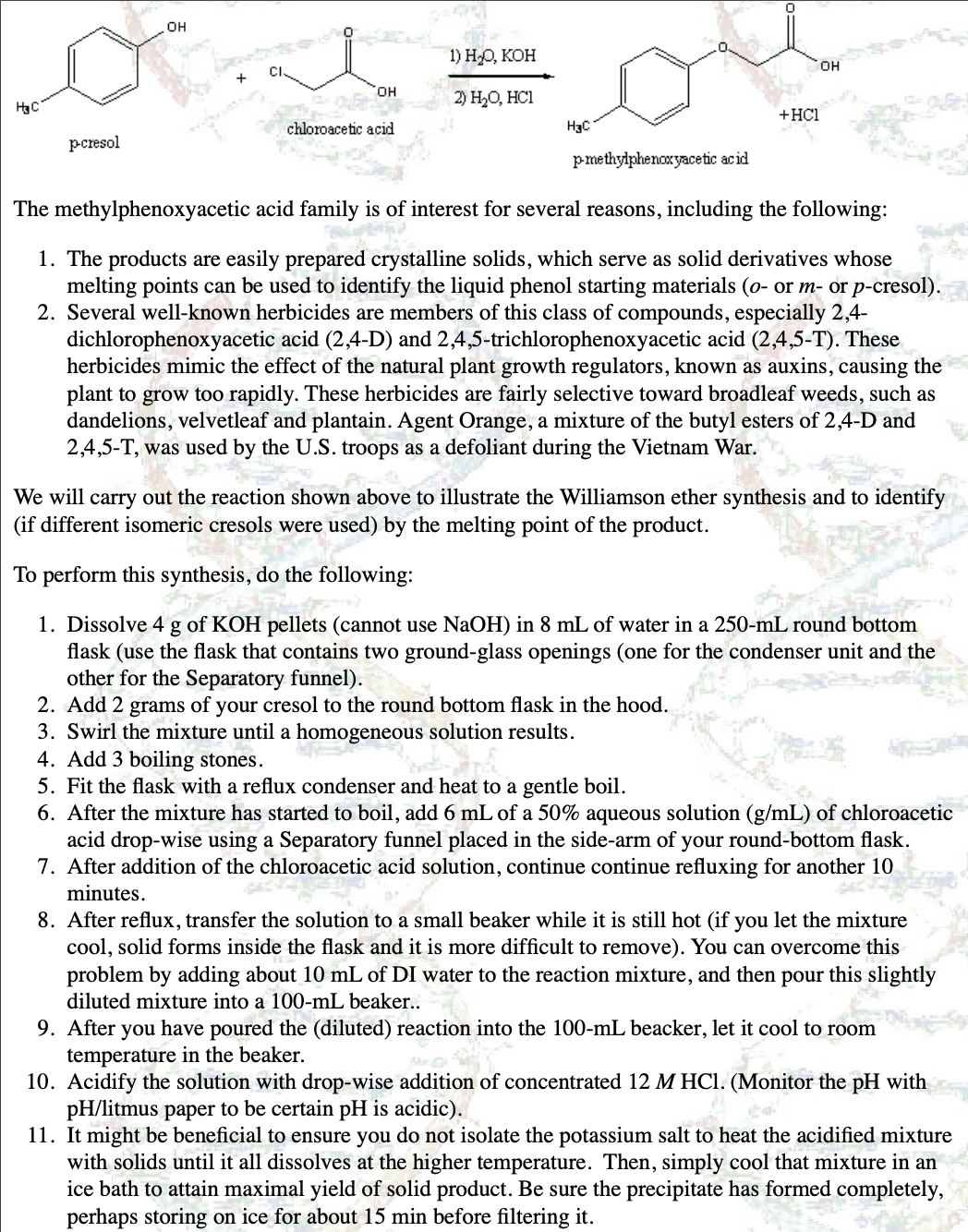Chapter17: Alcohols And Phenols
Section17.SE: Something Extra
Problem 37AP: Give IUPAC names for the following compounds:
Related questions
Question
Outline the SN2 mechanism for this reaction. for the
Williamson Ether Synthesis

Transcribed Image Text:OH
1) Н-О, КОН
OH
CI.
HO.
2) H2O, HC1
+HC1
chloroacetic acid
H3C
pcresol
pmethylphenoxyacetic acid
The methylphenoxyacetic acid family is of interest for several reasons, including the following:
1. The products are easily prepared crystalline solids, which serve as solid derivatives whose
melting points can be used to identify the liquid phenol starting materials (o- or m- or p-cresol).
2. Several well-known herbicides are members of this class of compounds, especially 2,4-
dichlorophenoxyacetic acid (2,4-D) and 2,4,5-trichlorophenoxyacetic acid (2,4,5-T). These
herbicides mimic the effect of the natural plant growth regulators, known as auxins, causing the
plant to grow too rapidly. These herbicides are fairly selective toward broadleaf weeds, such as
dandelions, velvetleaf and plantain. Agent Orange, a mixture of the butyl esters of 2,4-D and
2,4,5-T, was used by the U.S. troops as a defoliant during the Vietnam War.
We will carry out the reaction shown above to illustrate the Williamson ether synthesis and to identify
(if different isomeric cresols were used) by the melting point of the product.
To perform this synthesis, do the following:
1. Dissolve 4 g of KOH pellets (cannot use NaOH) in 8 mL of water in a 250-mL round bottom
flask (use the flask that contains two ground-glass openings (one for the condenser unit and the
other for the Separatory funnel).
2. Add 2 grams of your cresol to the round bottom flask in the hood.
3. Swirl the mixture until a homogeneous solution results.
4. Add 3 boiling stones.
5. Fit the flask with a reflux condenser and heat to a gentle boil.
6. After the mixture has started to boil, add 6 mL of a 50% aqueous solution (g/mL) of chloroacetic
acid drop-wise using a Separatory funnel placed in the side-arm of your round-bottom flask.
7. After addition of the chloroacetic acid solution, continue continue refluxing for another 10
minutes.
8. After reflux, transfer the solution to a small beaker while it is still hot (if you let the mixture
cool, solid forms inside the flask and it is more difficult to remove). You can overcome this
problem by adding about 10 mL of DI water to the reaction mixture, and then pour this slightly
diluted mixture into a 100-mL beaker..
9. After you have poured the (diluted) reaction into the 100-mL beacker, let it cool to room
temperature in the beaker.
10. Acidify the solution with drop-wise addition of concentrated 12 M HC1. (Monitor the pH with
pH/litmus paper to be certain pH is acidic).
11. It might be beneficial to ensure you do not isolate the potassium salt to heat the acidified mixture
with solids until it all dissolves at the higher temperature. Then, simply cool that mixture in an
ice bath to attain maximal yield of solid product. Be sure the precipitate has formed completely,
perhaps storing on ice for about 15 min before filtering it.
Expert Solution
This question has been solved!
Explore an expertly crafted, step-by-step solution for a thorough understanding of key concepts.
Step by step
Solved in 3 steps with 2 images

Knowledge Booster
Learn more about
Need a deep-dive on the concept behind this application? Look no further. Learn more about this topic, chemistry and related others by exploring similar questions and additional content below.Recommended textbooks for you

